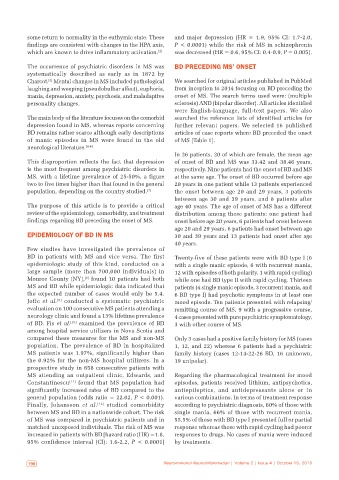Page 204 - Read Online
P. 204
some return to normality in the euthymic state. These and major depression (HR = 1.9, 95% CI: 1.7‑2.0,
findings are consistent with changes in the HPA axis, P < 0.0001) while the risk of MS in schizophrenia
which are known to drive inflammatory activation. [2] was decreased (HR = 0.6, 95% CI: 0.4‑0.9, P = 0.005).
The occurrence of psychiatric disorders in MS was BD PRECEDING MS’ ONSET
systematically described as early as in 1872 by
Charcot. Mental changes in MS included pathological We searched for original articles published in PubMed
[3]
laughing and weeping (pseudobulbar affect), euphoria, from inception to 2014 focusing on BD preceding the
mania, depression, anxiety, psychosis, and maladaptive onset of MS. The search terms used were: (multiple
personality changes. sclerosis) AND (bipolar disorder). All articles identified
were English‑language, full‑text papers. We also
The main body of the literature focuses on the comorbid searched the reference lists of identified articles for
depression found in MS, whereas reports concerning further relevant papers. We selected 16 published
BD remains rather scarce although early descriptions articles of case reports where BD preceded the onset
of manic episodes in MS were found in the old of MS [Table 1].
neurological literature. [4‑6]
In 26 patients, 20 of which are female, the mean age
This disproportion reflects the fact that depression of onset of BD and MS was 33.42 and 38.46 years,
is the most frequent among psychiatric disorders in respectively. Nine patients had the onset of BD and MS
MS, with a lifetime prevalence of 25‑50%, a figure at the same age. The onset of BD occurred before age
two to five times higher than that found in the general 20 years in one patient while 13 patients experienced
population, depending on the country studied. [7] the onset between age 20 and 29 years, 3 patients
between age 30 and 39 years, and 8 patients after
The purpose of this article is to provide a critical age 40 years. The age of onset of MS has a different
review of the epidemiology, comorbidity, and treatment distribution among these patients: one patient had
findings regarding BD preceding the onset of MS. onset before age 20 years, 6 patients had onset between
age 20 and 29 years, 6 patients had onset between age
EPIDEMIOLOGY OF BD IN MS 30 and 39 years and 13 patients had onset after age
40 years.
Few studies have investigated the prevalence of
BD in patients with MS and vice versa. The first Twenty‑five of these patients were with BD type I (6
epidemiologic study of this kind, conducted on a with a single manic episode, 6 with recurrent mania,
large sample (more than 700,000 individuals) in 12 with episodes of both polarity, 1 with rapid cycling)
Monroe County (NY), found 10 patients had both while one had BD type II with rapid cycling. Thirteen
[8]
MS and BD while epidemiologic data indicated that patients (4 single manic episode, 3 recurrent mania, and
the expected number of cases would only be 5.4. 6 BD type I) had psychotic symptoms in at least one
Joffe et al. conducted a systematic psychiatric mood episode. Ten patients presented with relapsing/
[9]
evaluation on 100 consecutive MS patients attending a remitting course of MS, 9 with a progressive course,
neurology clinic and found a 13% lifetime prevalence 4 cases presented with pure psychiatric symptomatology,
of BD. Fis et al. [10] examined the prevalence of BD 3 with other course of MS.
among hospital service utilizers in Nova Scotia and
compared these measures for the MS and non‑MS Only 3 cases had a positive family history for MS (cases
population. The prevalence of BD in hospitalized 1, 12, and 22) whereas 6 patients had a psychiatric
MS patients was 1.97%, significantly higher than family history (cases 12‑14‑22‑26 BD, 16 unknown,
the 0.92% for the non‑MS hospital utilizers. In a 19 unipolar).
prospective study in 658 consecutive patients with
MS attending an outpatient clinic, Edwards, and Regarding the pharmacological treatment for mood
Constantinescu [11] found that MS population had episodes, patients received lithium, antipsychotics,
significantly increased rates of BD compared to the antiepileptics, and antidepressants alone or in
general population (odds ratio = 22.02, P < 0.001). various combinations. In terms of treatment response
Finally, Johansson et al. [12] studied comorbidity according to psychiatric diagnosis, 60% of those with
between MS and BD in a nationwide cohort. The risk single mania, 66% of those with recurrent mania,
of MS was compared in psychiatric patients and in 55.5% of those with BD type I presented full or partial
matched unexposed individuals. The risk of MS was response whereas those with rapid cycling had poorer
increased in patients with BD [hazard ratio (HR) =1.8, responses to drugs. No cases of mania were induced
95% confidence interval (CI): 1.6‑2.2, P < 0.0001] by treatments.
196 Neuroimmunol Neuroinflammation | Volume 2 | Issue 4 | October 15, 2015 Neuroimmunol Neuroinflammation | Volume 2 | Issue 4 | October 15, 2015 197

